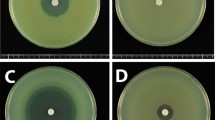Abstract
Resistance to polymycin B or E (colistin) in the disk test, which is used as a means of identification, was tested in 43 strains of Serratia marcescens and 26 of Serratia liquefaciens.While all strains had MIC values > 32 mg/l for colistin, false susceptibility to both polymyxins was encountered in the 24 h disk test in 9 % of Serratia marcescens and 12–96% of Serratia liquefaciens strains, depending on the kind of polymyxin, temperature and duration of incubation. Using colistin disks and incubation at 25 °C for 48 h, the percentage of false susceptible results could be minimized.
Similar content being viewed by others
References
von Graevenitz, A.: The use of antimicrobial agents as tools in epidemiology, identification, and selection of microorganisms. In: Lorian, V. (ed.): Antibiotics in laboratory medicine. Williams & Wilkins, Baltimore, 1986, p. 810–824.
Jawetz, E.: Polymyxin, colistin, and bacitracin. Pediatric Clinics of North America 1961, 8: 1057–1071.
Farrar, W. E.: Antimicrobial susceptibility of clinical isolates, synergistic effects, and beta-lactamases ofSerratia. In: von Graevenitz, A., Rubin, S. J. (ed.): The genusSerratia. CRC Press, Boca Raton, 1980, p. 121–138.
Acar, J. F., Goldstein, F. W.: Disk susceptibility test. In: Lorian, V. (ed.): Antibiotics in laboratory medicine. Williams & Wilkins, Baltimore, 1986, p. 27–63.
Baudens, J. G., Ham, L., Chabbert, Y. A.: Action des polymyxines et de l'acide nalidixique sur les serratiae. In: Spitzy, K. H., Haschek, H. (ed.): Proceedings of the 5th International Congress of Chemotherapy, Vienna, 1967, Volume 3. Verlag der Wiener Medizinischen Akademie, Wien, 1967, p. 99–102.
Annear, D. I.: An optimal zone of colistin activity withSerratia marcescens. Medical Journal of Australia 1970, ii: 225–227.
Traub, W.: Polymyxin B-induced cocarde growth phenomenon ofSerratia marcescens due to cationic detergent-like activity of polymyxin B. Chemotherapy 1982, 28: 363–368.
Thrupp, L.: Susceptibility testing of antibiotics in liquid media. In: Lorian, V. (ed.): Antibiotics in laboratory medicine. Williams & Wilkins, Baltimore, 1986, p. 93–150.
Piguet, J. D.: Oxydation et fermentation de l'arabinose, du mélibiose et du xylose parSerratia. Annales de l' Institut Pasteur 1978, 129B: 167–173.
Oberhofer, T. R., Hajkowski, R.: Evaluation of nonlactose fermenting members of theKlebsiella-Enterobacter-Serratia division. II: Anitbiotic susceptibility. American Journal of Clinical Pathology 1970, 54: 726–732.
Poupard, J. A., Dewees, L. B., Morton, H. E.: Antibiotic susceptibility ofKlebsiella-Enterobacter as determined by a single high-concentration disc method. Antimicrobial Agents and Chemotherapy 1969, 489–494.
Author information
Authors and Affiliations
Rights and permissions
About this article
Cite this article
von Graevenitz, A., Zollinger-Iten, J. Reliability of the colistin disk test in identification ofSerratia marcescens andSerratia liquefaciens . Eur. J, Clin. Microbiol. 6, 70–71 (1987). https://doi.org/10.1007/BF02097199
Issue Date:
DOI: https://doi.org/10.1007/BF02097199




